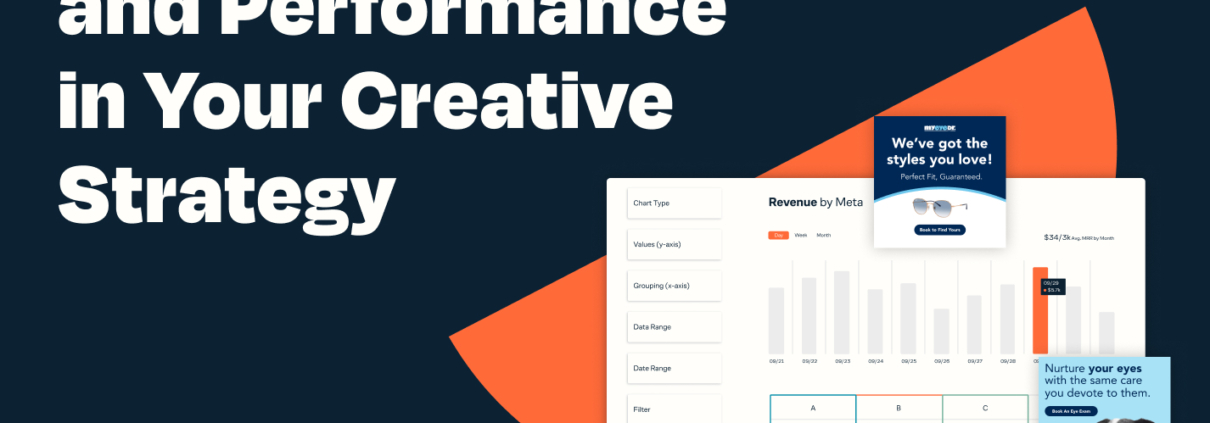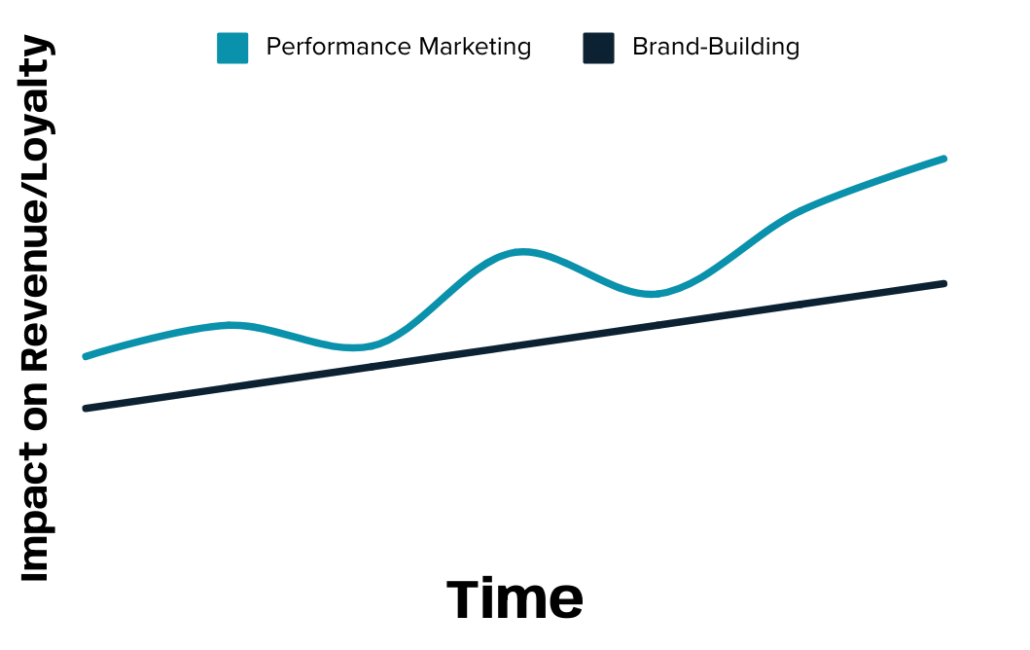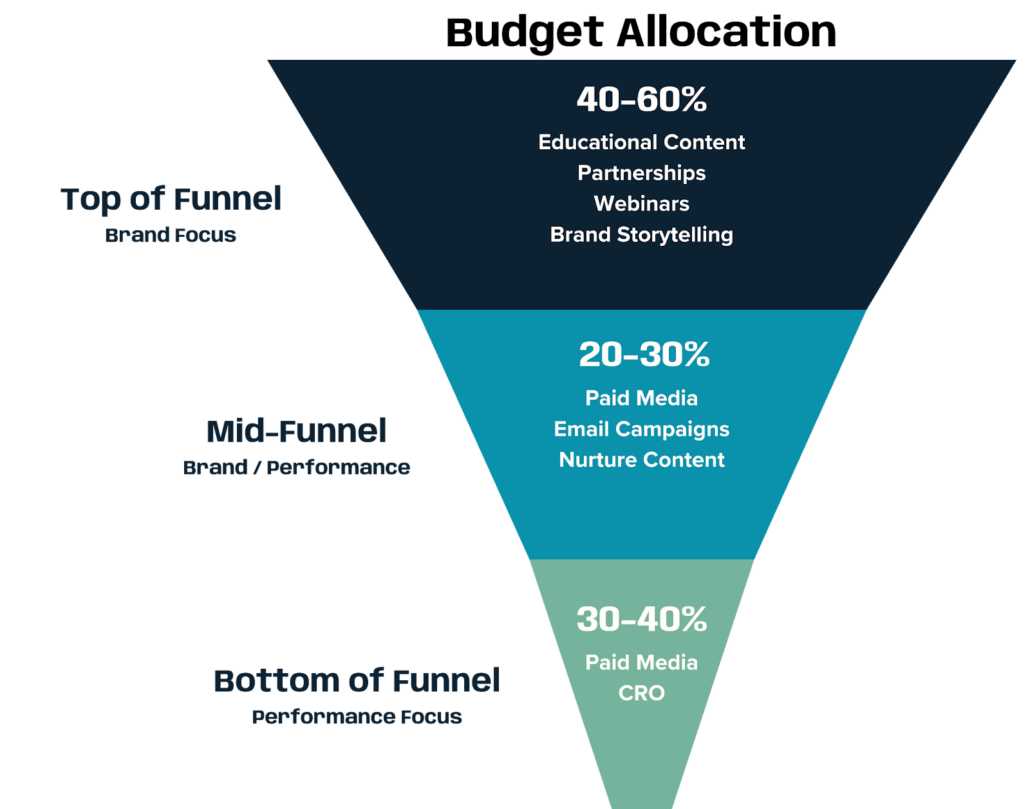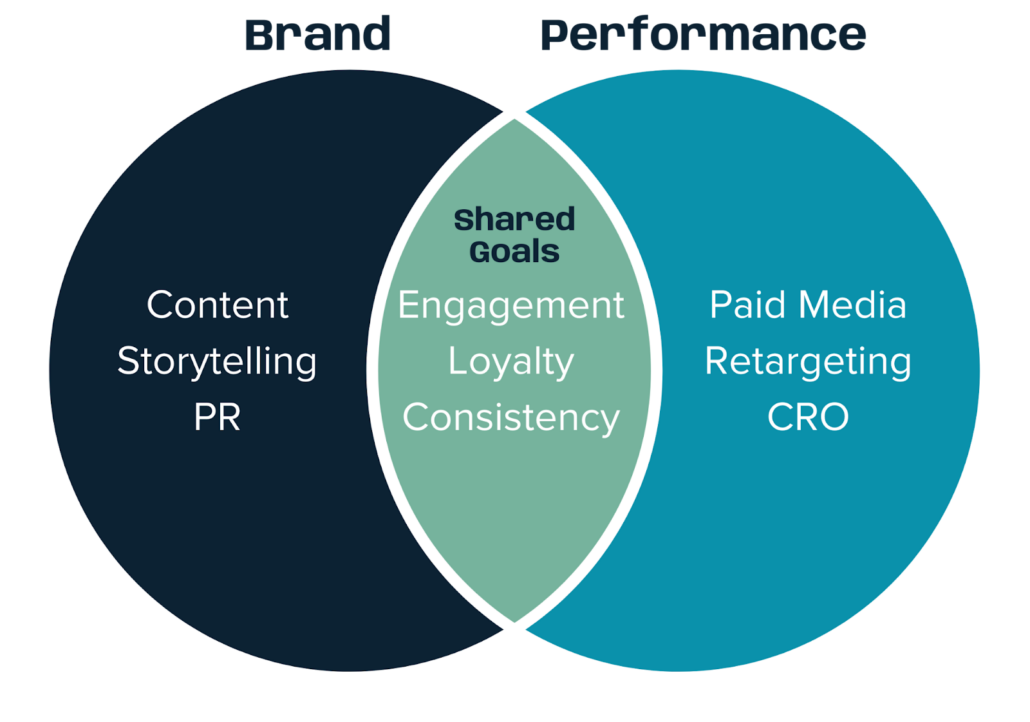Balancing Brand and Performance in Your Creative Strategy

In this post, we’ll show you how to align brand and performance marketing, optimize your budget, and track the right KPIs to fuel sustainable growth.
The Need for Balance Between Brand and Performance
Brand marketing creates emotional connections and long-term trust, while performance marketing drives immediate sales and signups. Both are critical, but focusing too much on one can hurt the other.
In business models where sales cycles are often lengthy, brand-building content like webinars, case studies, and thought leadership is essential for nurturing leads and building trust over time. For brands with lower AOVs and quicker sales timelines, immediate conversions are often the priority, making bottom-funnel strategies like retargeting critical.
However, investing in brand-building early on can reduce reliance on discounts and promotions, boosting long-term customer loyalty and value. Striking the right balance between brand and performance marketing drives success across both industries.
Aligning Goals and Budget Across the Funnel
Balancing brand and performance marketing requires more than just aligning objectives across the funnel. We recommend careful budgeting at each stage to ensure you’re investing in the right areas for both long-term brand-building and short-term revenue generation.
Here’s a deeper look at how to align both goals and budgets across the funnel:
Top-of-Funnel (Brand Marketing)
At this stage, your goal is to build brand awareness, trust, and recognition. You’re engaging an audience that might not be familiar with your brand, so your content should be designed to tell your story and demonstrate value. The focus is on creating familiarity and positive associations.
- Key Metrics: Brand lift, reach, impressions, brand recall
- Strategy: Invest in educational, narrative, or thought leadership content that helps introduce your brand to a broader audience. Owned media like blogs, social posts, and PR are crucial here, as are earned media opportunities through influencer mentions, press, or social shares. By focusing on brand storytelling, you create a narrative that not only informs but also builds an emotional connection with potential customers.
- Budget Allocation: 40%-60% of your total marketing budget should be dedicated to brand-building at the top of the funnel. For example, if your total marketing budget is $1M for the year, consider investing $400K-$600K on top-funnel activities like educational content and brand storytelling. These efforts could include blogs, webinars, or influencer partnerships that build recognition and trust. Focus on owned and earned media, with the majority of spend allocated to content creation and organic engagement.
Mid-Funnel (Transitioning from Brand to Performance)
At this stage, prospects are moving from awareness to consideration. They know your brand exists, and now it’s time to engage them deeper by nurturing their interest and gradually shifting toward performance marketing tactics that drive action.
- Key Metrics: Website visits, time on site, engagement, lead generation
- Strategy: To maximize mid-funnel engagement, the focus is on capturing our audience’s footprint to begin nurturing them on our owned properties as well as paid. Using tools like HubSpot or Klaviyo, brands should set up personalized drip campaigns based on lead behavior. We often find that building new funnel entry points—like interactive content or educational resources—enables consumers to engage deeper with a brand without necessarily buying. For example, in our work with Rewiring America, we created early paid campaigns designed to educate and engage audiences on clean energy benefits, positioning the brand as a trusted resource while nurturing prospects further down the funnel.
Leverage dynamic content to tailor email sequences based on user interactions—whether they’ve viewed a demo, downloaded content, or abandoned a cart. Segmentation and automation ensure that each lead is receiving highly relevant, personalized content, driving deeper engagement and conversions.
- Budget Allocation: 20%-30% of your total budget should focus on this mid-funnel area. Allocate funds to both paid (retargeting ads, sponsored webinars) and organic channels (email drip campaigns, lead nurturing content) to move prospects further down the funnel. Split your resources equally between brand reinforcement and performance marketing efforts to drive leads.
Bottom-of-Funnel (Performance Marketing)
At the bottom of the funnel, the priority is driving conversions—whether that’s closing a sale, capturing a lead, or securing a demo. This is where performance marketing is most effective, delivering measurable results through direct actions.
- Key Metrics: Revenue, Incrementality, Conversion rates, Customer Acquisition Cost (CAC), Return on Ad Spend (ROAS).
- Strategy: Focus on paid performance campaigns with strong calls-to-action (CTAs), like PPC ads, retargeting, and email remarketing. Offer product demos, free trials, or limited-time offers to nudge prospects over the conversion line. Paid media should dominate at this stage, with tightly targeted campaigns to ensure you’re reaching an audience primed for action.
- Budget Allocation: 30%-40% of your budget should go towards bottom-funnel activities. These funds should be invested heavily in performance-focused channels, such as paid search, retargeting, and high-conversion media types (e.g., display or social ads) designed to capture direct responses. Here, you’re prioritizing immediate returns on investment and optimizing for the lowest CAC.
Key Takeaway: Budget allocation should evolve as prospects move down the funnel, with higher investments in brand-building at the top, transitioning to heavier performance spends at the bottom. By aligning both objectives and budgets, you ensure your marketing strategy supports both long-term brand growth and short-term conversions.
Creating a Unified Brand and Performance Strategy
To successfully align brand and performance strategies across your teams, ensure clear communication of shared goals. Marketing leaders must ensure that creative, brand, and performance teams are aligned, even when faced with conflicting priorities. Establishing cross-functional KPIs is crucial, especially in times of economic uncertainty when budgets might tighten. By ensuring both brand and performance teams are jointly responsible for metrics like Engagement-to-Conversion Rate or Customer Lifetime Value (CLV), marketing leaders can foster collaboration and ensure a balanced focus on both long-term brand growth and short-term revenue.
One way to do this is by implementing cross-functional KPIs, where brand and performance teams are jointly responsible for metrics like Engagement-to-Conversion Rate or Brand-Performance Crossover. This fosters alignment and shared accountability, making it easier to balance long-term brand-building and short-term revenue goals.
Consistent Messaging Across All Channels
Consistency in messaging is crucial. Whether a customer interacts with your brand via social media, email, or paid ads, they should have a unified experience that reflects the same core values, tone, and messaging. This helps build trust and reinforces your brand identity across every touchpoint.
- Unified Brand Voice: Your brand voice should remain consistent across all platforms, whether you’re engaging through organic content, paid ads, or email campaigns. A clear and unified voice helps customers feel like they are interacting with the same brand, regardless of the channel. This is critical in ensuring that your performance marketing campaigns don’t feel disconnected from your overall brand narrative.
- Visual Consistency: Beyond messaging, maintaining consistent visual elements such as colors, fonts, logos, and imagery reinforces brand recognition. Whether a customer encounters your brand through a display ad or a blog post, the experience should feel cohesive.
When both brand and performance messaging are aligned, it strengthens the overall perception of your business and keeps customers engaged at every stage of the funnel.
How Brand Marketing Enhances Performance
A well-established brand can elevate your performance marketing efforts. When your audience is already familiar with your brand, it’s easier to drive conversions because you’ve already built trust and credibility. Without a strong brand or differentiated value propositions, many companies rely heavily on discounts and promotional offers to drive conversions, which can eat into margins. Here’s how brand-building improves performance marketing outcomes and reduces dependency on discounting:
- Improved Conversion Rates: When your audience recognizes and trusts your brand, they’re more likely to engage with your performance ads and take action. Strong brand recognition means performance campaigns have a higher chance of success, as customers already feel connected to your business—without the need for promos.
- Lower Customer Acquisition Costs (CAC): A strong brand presence reduces the effort needed to persuade prospects. This results in a lower cost per acquisition, as your audience already knows and trusts you, making them more likely to convert. Building brand equity also allows you to achieve conversions without relying on margin-eroding discounts.
- Storytelling for Engagement: Performance ads that incorporate brand storytelling drive deeper emotional engagement, which can lead to higher click-through rates (CTR) and conversions. Use your brand’s narrative to create performance ads that resonate on a personal level with your audience.
How Performance Marketing Fuels Brand Growth
On the flip side, performance marketing doesn’t just drive immediate results; it also generates data and insights that can be used to refine your brand strategy. By analyzing performance data, you can continuously improve how you communicate your brand’s message.
- Data-Driven Brand Refinement: Performance marketing provides measurable results that show which messages, channels, and audiences resonate best. This data can inform your overall brand strategy, helping you fine-tune your messaging and reach the right audience with the right content.
- Audience Insights: Performance marketing campaigns give you valuable insights into customer behavior, demographics, and preferences. Use this information to sharpen your brand positioning and make sure your branding reflects the needs and desires of your target market.
- Testing for Consistency: By testing different messages, creative assets, and CTAs in performance campaigns, you can ensure that your brand’s core values and identity remain consistent while optimizing for better engagement and conversions.
Key Takeaway: Consistent messaging across channels is vital for creating a seamless customer experience, but when combined with performance marketing, it also drives measurable results. A unified brand strategy boosts the effectiveness of performance campaigns by enhancing trust and recognition, while performance data provides valuable insights to continuously refine your brand messaging.
By aligning brand and performance efforts, you create a marketing strategy that works together to achieve both short-term wins and long-term brand loyalty. When done correctly, your brand becomes a powerful tool to elevate performance marketing, and performance marketing, in turn, fuels your brand’s ongoing evolution.
Measuring KPIs for Brand and Performance Integration
Balancing brand and performance marketing requires tracking the right KPIs to measure both long-term brand value and short-term conversion goals. This ensures you’re not just focusing on immediate wins but also building a brand that resonates and sticks with your audience.
Brand Marketing KPIs
Brand marketing metrics are harder to measure because the effects are long-term and qualitative. However, key indicators include:
- Brand Awareness: Measure brand recall, brand lift, reach and impressions across social media, search, and display networks.
- Brand Sentiment: Use surveys, social listening tools, and review platforms to measure how people feel about your brand.
- Social Engagement: Track likes, shares, and comments on organic posts to understand how your audience interacts with your brand.
Performance Marketing KPIs
Performance marketing metrics are more straightforward and measurable in the short term. These KPIs focus on driving action and conversions:
- Conversions: Track sales, sign-ups, or other desired actions.
- Customer Acquisition Cost (CAC): Calculate how much it costs to acquire a new customer.
- Return on Ad Spend (ROAS): Measure how much revenue you’re generating for every dollar spent on ads.
- Incremental Revenue Growth: Measure additional revenue directly attributed to performance marketing efforts.
Integrating Brand and Performance Metrics
While brand and performance marketing can seem separate, they are most effective when working together. For example:
- Brand-Performance Crossover: Track how brand-building campaigns influence performance marketing results.
- Engagement-to-Conversion Rate: Measure how brand engagement leads to conversions.
Key Takeaway: Measuring the right KPIs for both brand and performance marketing ensures you’re tracking long-term brand value alongside short-term conversion goals. By integrating data from both strategies, you can continuously refine your approach, maximizing immediate results while strengthening your brand’s long-term growth and recognition.
Conclusion: Balancing Patience and Agility for Long-Term Success
To wrap things up, let’s ask the critical question: How do you build a brand that lasts while still hitting those short-term revenue goals? The answer is balancing patience and agility—investing in brand-building for the long haul while using performance marketing to drive immediate results.
- Brand-building is a long-term investment—it takes time to build trust, loyalty, and emotional connections with your audience. While the payoff isn’t immediate, it delivers benefits like customer retention and higher lifetime value (LTV).
- Performance marketing, on the other hand, offers the agility needed to test and optimize quickly, delivering immediate, measurable results like higher conversions and faster revenue growth.
Focusing too much on one side can be risky:
- Over-reliance on performance marketing: You may see quick wins, but without building lasting brand recognition, long-term growth will be difficult.
- Over-reliance on brand-building: Great awareness might result, but without immediate performance, your business may struggle to see conversions.
The ideal strategy is a balance that integrates both:
Brand-building lays the foundation for trust and recognition, making performance campaigns more effective. During times of budget tightening, marketing leaders should prioritize high-impact brand-building activities that lay the groundwork for future growth, while continuing to invest in performance marketing for immediate returns.
Key Takeaway: Combining patience in brand-building with agility in performance marketing is the winning formula for long-term success. By continually refining your strategies, you’ll build a brand that thrives in the short term and stands strong for years to come.
Hey! I’m HB, the Head of Creative Ops at Tuff. With a decade of experience across marketing and web, I specialize in complex problem-solving, strategic planning, and organic acquisition. My focus is on facilitating client growth, supporting our creative teams, and consistently improving efficiency across our org. Let’s chat!







